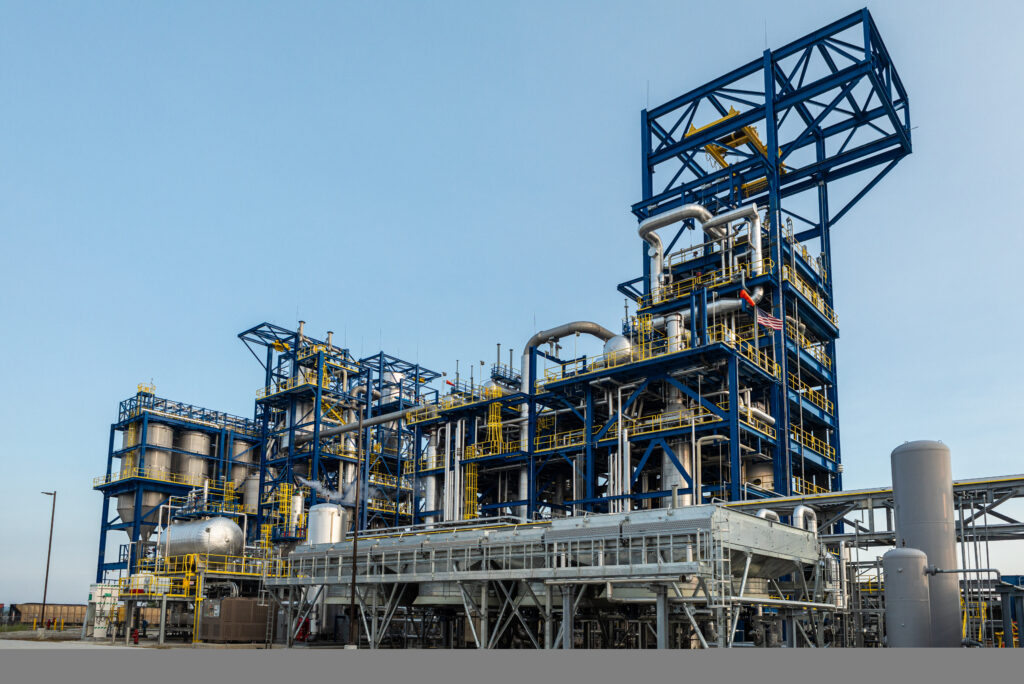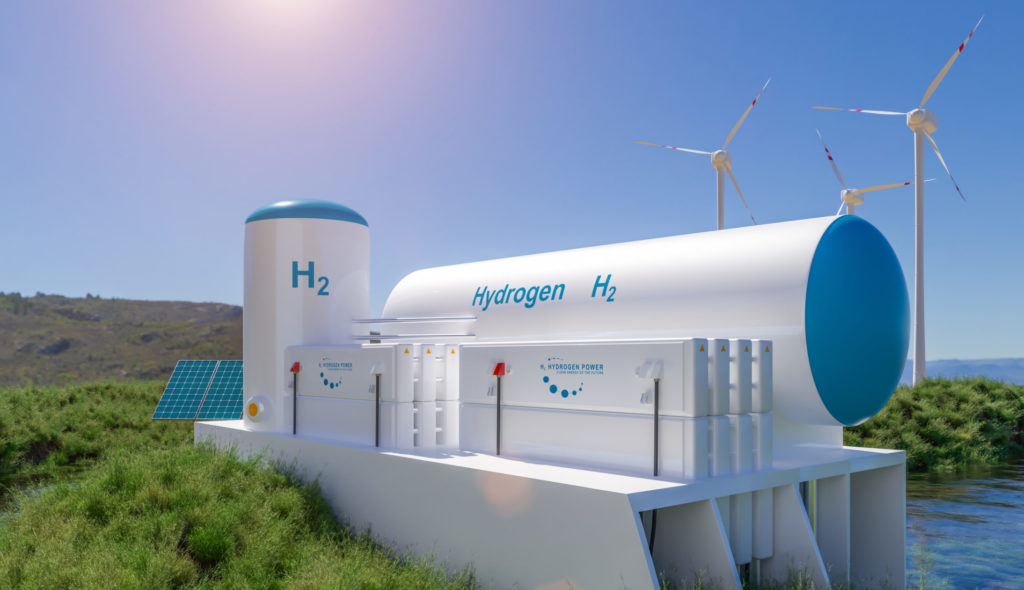Climate News Weekly Episode 136
January 9, 2024
Green hydrogen tax credit rules, Chinese EVs dominate, Louisiana LNG exports, and more
In this Episode
In this week’s episode of Climate News Weekly, Julio Friedman, Dina Cappiello, and Darren Hau join James Lawler to discuss the US Treasury’s new guidance for what can qualify for a “green hydrogen” tax credit, Tesla no longer being the world’s largest EV manufacturer, the EPA granting Louisiana the right to manage applications for deep geologic storage of CO2, and an update on a proposed Liquid Natural Gas (LNG) project in the Gulf Coast.
Related Media:


Climate Now: Jul 27, 2021
Hydrogen Electrolysis with Ben Wiley
Declining renewable energy costs have sparked a renewed interest in green hydrogen, which has the potential to decarbonize sectors in which electricity cannot. Because hydrogen doesn’t occur by itself on Earth, it must be separated from other elements, s


Climate Now: Apr 3, 2023
Making hydrogen and carbon black out of renewable natural gas
Renewable natural gas (RNG), made from the decomposition of organic waste like livestock manure, is not necessarily net-zero if it’s burned to run a turbine or drive a car. But what if the RNG is not burned, but is rather pyrolyzed, breaking it down in


Technologies Ep 1
Clean Fuel: Hydrogen Fuel
Hydrogen is uniquely qualified as a storage of clean energy because it is abundant – the most abundant element in the universe – and it can be produced using renewable energy. When consumed in a fuel cell, its only byproduct is water, making it
Episode Transcript
TRANSCRIPT
James Lawler: [00:00:00] Welcome to Climate News Weekly. It is great to be back in the year 2024, and joined by our co-hosts here, we’ve got Julio Friedmann, Darren Hau, and Dina Cappiello. Good to see you guys.
Julio Friedmannn: Happy new year.
Darren Hau: Happy new year.
Dina Capiello: Happy new year.
James Lawler: We have a number of stories we want to get through today so we’re going to start the year with a story on hydrogen. This is sort of a multi-pronged story. There are different facets to it. Number one, guidance has come from the United States treasury department on the 45 V provision from the IRA. Julio, tell us about the guidance that’s come down and what the implications are for hydrogen production projects in the United States.
Julio Friedmannn: Yeah. So we’ve been waiting for this guidance for a long time. Uh, it was going to be controversial. Unsurprisingly, it was released the day before Christmas in the evening. So it was, it was meant to be buried, but it was a big news story nonetheless and we are glad to see it out. The back and forth was between two groups, one of which wanted more stringent controls saying they [00:01:00] wanted three pillars of environmental protection, the other group said it is more important to have growth, it is more important to establish this new industry so we can bring stringency in later.
Essentially, the first group won. The three environmental pillars are well represented in the guidance, and they basically say you need to have additional supply meaning it has to be new renewable electricity. It has to match on an hourly basis, meaning that the electricity that is used to make green hydrogen must be dispatched at that time from green electricity, and then last but not least, it has to be geographically co-located. You have to have these things all in one place. And they said that basically you can do monthly matching until 2028, after that point, it has to be these three pillars kind of thing.
We will see how this goes. I personally believe that it will kill a bunch of projects. I believe that it will slow deployment and the economic headwinds are starting to bear [00:02:00] that out. Nonetheless, it is in fact not only important for clean hydrogen and it burnishes the administration’s environmental records, it actually sets a precedent for all other kinds of green electricity use. So if you want to use green electricity to do direct air capture, if you want to use green electricity to decarbonize a steel mill, it sets a precedent for how that goes as well.
James Lawler: Just to provide the full context here, hydrogen project developers, you know, were very excited about this idea that they could claim a significant subsidy per kilogram of hydrogen if they made it in a quote green way. So that could be up to three dollars per kilogram of hydrogen produced with the most greenest, you know, electricity coming in and just to remind our listeners, what is green hydrogen? It’s hydrogen then produced through electrolysis, basically where you’re running electricity through water to produce hydrogen.
Julio Friedmannn: The guidance doesn’t restrict anything. It just says, if you want to get this much money, you got to do X, Y, and Z, which are the three pillars, and you got to do it by [00:03:00] 2028. And importantly, you know, for the environmental movement, the people who were advocating in group one, the thing they were worried about was using a lot of grid electricity that would be dirty.
James Lawler: Right.
Julio Friedmannn: They were legitimately concerned about increasing emissions from deployment of electric hydrogen.
James Lawler: Yeah. Another story from last week is that BYD auto company, which is based out of China, has overtaken Tesla to become the world’s biggest EV producer. Darren, tell us about this story.
Darren Hau: Yeah, absolutely. This one is kind of a, one of those 10, 20-year overnight successes. Essentially the crux of the story is that BYD, a Chinese battery vehicle and hybrid manufacturer has overtaken Tesla as the world’s largest producer of EVs.
This is obviously major news, but it also wasn’t something that was too surprising. I think what’s worth drawing is the distinction that Tesla and BYD had in their [00:04:00] approach. So Tesla’s approach, as many people in our audience probably know, is to start with high end, luxurious EVs that are super high performance, attract new buyers and subsidize more mass market EVs.
So that mass market EV so far has been the Model 3 and Model Y, which have been incredibly successful. Model Y has been the most popular car period, which is quite remarkable. That being said, BYD is a Chinese company that has actually been in business for, you know, more than two decades, and they started out supplying batteries for all sorts of electronic devices and only after doing that for a while, decided to get into the EV and hybrid game.
The interesting thing with the BYD is that they took kind of the opposite approach, they weren’t really known as a status luxury automaker. They decided to start making really cheap, really mass-market taxis and buses to start out.
And I think why that approach worked for them is because they started out building the batteries. So they wanted to find applications that could [00:05:00] ramp up their capacity quickly. So even if the product itself was lower margin, it meant that they could produce more batteries. What will be interesting to see is they’ve been very successful in their home market of China and now are aiming to expand globally. So the big question is whether they’ll be able to repeat their success in other markets.
James Lawler: Another significant story is that the state of Louisiana has just received class six primacy to oversee permitting of their class six wells to inject carbon dioxide underground. Julio, as our carbon management expert, tell us about that.
Julio Friedmannn: So class six represents a class of wells that operates under the underground injection control protocol by the EPA. It basically restricts the context in which you can inject stuff underground, whether it’s for mining or for hazardous waste disposal, class six is for carbon dioxide disposal. This was a new class of underground injection control well, that was created in 2010.
Right now there’s 170 plus permit requests for class six [00:06:00] and that backlog at the EPA is a problem. A number of states have requested primacy, North Dakota and Wyoming received it. Louisiana is the third that also happened over the Christmas break and they basically allow the state of Louisiana to manage this process.
Administrator Regan, Michael Regan of the EPA tried to make clear that this is in no way, shape, or form a dilution of the regulation. In order to do this, Louisiana must conform to the standards of the well class as directed by the EPA, it just allows their people to do the processing.
We’ll see if that’s true. Uh, a reasonable number of environmental groups are concerned that in point of fact, the state of Louisiana won’t do what needs to be done to manage safe underground injection of carbon dioxide. Still, this will debottleneck a lot of these permits. Governor [00:07:00] Edwards has been pushing for this hard and it’s a big win for him and for the state and we’re going to see carbon capture done for direct air capture at one of the big direct air capture hubs that’s in Louisiana. We’re going to see for blue hydrogen projects with 95 percent capture, we’re going to see LNG export terminals reconfigured for capturing CO2 from their gas polishing and from their ice boxes and power plants.
And the overwhelming majority of the 78 percent of all CCS projects in the world are now for dedicated storage and 100 percent of the class six wells are for dedicated storage without EOR. So it’s a major shift in the paradigm and a major shift in the regulatory environment.
James Lawler: Thanks, Julio. It’s worth mentioning, I think, that, you know, when you do capture emissions, you know, for underground storage, you’re also capturing quite a few co-pollutants at the same time, so the benefits are not just kind of broadly shared from a climate and emissions [00:08:00] perspective, but also from, you know, local communities experiencing less local air pollution in those contexts when that’s done. So it’s interesting news for Louisiana and for the, the future of, of CCS in that region.
Darren Hau: Yeah, I’ve got a question for you. This is interesting having this state primacy situation. Is this something that has been done for maybe other technologies before? Like, could this be a way to un-bottleneck solar and wind deployments? Or is that really bottlenecked by other things like interconnections?
Dina Capiello: Well state primacy is definitely not new in environmental regulations and the EPA has given state primacy before and usually it’s for permit approvals, right? So this is they require a permit and that’s what they’re seeking from the EPA and what the EPA is saying is that our counterparts at the state level can do this because we’re overwhelmed or whatever the explanation is. But that’s happened historically for decades, [00:09:00] um where the state can have primacy for air pollution permits, for new source review permits, for uh, water permits, et cetera, so it’s not new, and I, I think what’s interesting about this story is that here is a state, you know, obviously a predominant oil and gas state, have been drilling for oil and gas in Louisiana for a very long time, it’s that industry that has the technology and the know how to do this, right? They’ve been injecting things underground for many many years, for fracking in particular, and they know how to do it. I think the environmental concern is that Louisiana historically has been pretty lax when it comes to regulation of the industry and I think there is a big economic benefit here as well to whoever is operating these wells, right?
I mean, it’s the equivalent of taking a waste and putting it [00:10:00] underground. And there’s a lot of waste that goes underground now. I mean, I remember covering outside of Houston, Texas, an explosion at a well that was pumping hazardous waste, although it wasn’t classified as hazardous underground outside of Houston. And so, you know, I, I think my questions are, and probably the questions of a lot of other environmental NGOs are, are who’s going to police this, who’s going to regulate, make sure that there is no leakage, if this is permanent geological storage, and would just like to remind the listeners that, you know, CCS and, and most every model, right, is, is a small fraction of what we need to do to address the climate crisis. You know, mitigation is primal.
James Lawler: Right. Emissions reduction, you mean, right?
Dina Capiello: Correct.
James Lawler: For sure. Staying with Louisiana, our final story for this episode is about a liquefied natural gas or LNG terminal that [00:11:00] is being proposed in Louisiana. On December 27th of 2023, the U.S. Department of Energy released a notice of receipt of an application by Venture Global to authorize an LNG export terminal in Louisiana. So this terminal would increase daily LNG production from the U.S. by about 20 percent relative to the current rate of exports from all existing U. S. projects. So the DOE now has to review the potential impacts of exporting this amount of additional natural gas, and make a determination as to whether the terminal should be authorized.
If it’s approved, it would be one of the largest export terminals approved by the Biden administration. Dina, tell us more about the proposal and the significance of Venture Global’s application and the discussion around this.
Dina Capiello: It’s a 10 billion proposal by Venture Global is the company is that would enable the U.S. to export vast stores of liquefied natural gas. You know, those who support [00:12:00] the project say that this would be a boon for the U. S. economy. Obviously, we’re the largest oil and gas producer in the world. I just saw a headline, too, that I think at the end of last year or this month, it’s going to be a record setting production month that rivals a month back when Trump was in the White House.
But that said, those who are in support of it, I think it’s a huge financial boon to the U.S. economy and will also help Europe decrease its reliance on gas imported from Russia, which as everybody knows is in a war with Ukraine after their invasion of Ukraine. And they also claim that burning natural gas would produce fewer planet warming emissions than burning coal, which, as you know, RMI did some research that shows that with methane leaks across the natural gas system, natural gas can be worse than coal in some cases, even with minor, minor, minor leaks.
But this has now become a lightning rod for some in the environmental community [00:13:00] because of the emissions that would be associated with it globally. And a real test for the Biden administration, you’ll remember, I think it was over the summer, if my memory serves, they approved that big project in Alaska, the Willow project, and that was viewed really as Biden kind of, you know not – , being inconsistent on climate, right? We have the Inflation Reduction Act, biggest investment ever in clean energy technologies, but these projects are, from the environmental perspective, like a real test of, of his, his, his might on climate, especially heading into election where Trump could be the front runner.
Some environmentalists are like equating this to the fight over the Keystone Pipeline, which is also a huge pivotal moment, right? And so the, the facility is called CP2. It’s not the only LNG terminal [00:14:00] proposed, it just happens to be a very big one and so everybody’s sort of waiting with bated breath, you know, as the New York Times headlines said, A Natural Gas Project is Biden’s Next Big Climate Test.
And so what the enviros are really pushing for is to look at this from the life cycle greenhouse gas emission perspective. So what does this create in terms of the production, the shipping of the LNG, and the burning of the LNG, because as we know, when it comes to climate, it doesn’t really care, care where you burn it, right? Like as we become stricter here in this country, and because we’re such a huge producer, what are we creating abroad, right, that’s off our books, right?
So from the UN perspective, if we put LNG in a tanker ship and we ship it to Europe, those are not our emissions [00:15:00] anymore, right? So, so in one way, it looks like we clean up our act, but we’re still helping pollute the planet, and I think that’s, that’s where the debate is.
James Lawler: That’s it for this episode of Climate News Weekly. We’ll see you next week.
Climate Now is made possible in part by our science partners like the Livermore Lab Foundation. The Livermore Lab Foundation supports climate research and carbon cleanup initiatives at the Lawrence Livermore National Lab, which is a Department of Energy applied science and research facility. More information on the Foundation’s climate work can be found at livermorelabfoundation.org.